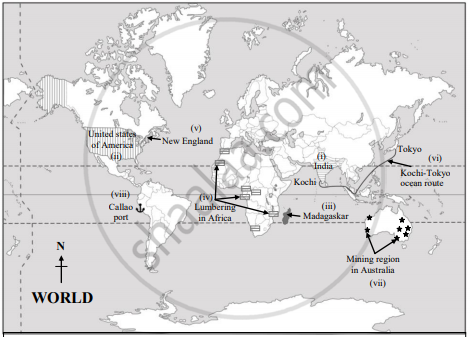Advertisements
Advertisements
प्रश्न
Show the following in the world map. Index is necessary
- Any one country in the third stage of population transition
- A country having dense population in North America
- Madagaskar
- Lumbering in Africa
- New England – Industrial region
- Kochi to Tokyo – ocean route
- Mining region of Australia
- Callao port
उत्तर

Index:
 - One country in the third stage of population transition India
- One country in the third stage of population transition India - A country having dense population in North America United states of America
- A country having dense population in North America United states of America - Madagaskar
- Madagaskar - Lumbering in Africa
- Lumbering in Africa - New England – Industrial region
- New England – Industrial region - Kochi to Tokyo – ocean route
- Kochi to Tokyo – ocean route - Mining region in Australia
- Mining region in Australia - Callao port
- Callao port
संबंधित प्रश्न
Draw neat, labelled diagram:
Demographic Transition Theory
Give geographical reason
India is passing through stage 3 of demographic transition.
Identify the incorrect factor
Stages of population transition theory:
Identify the incorrect factor
The countries in the second stage of population transition:
Identify the correct group
Population transition theory- fifth stage:
Differentiate between
1st and 5th stage of population transition theory
Differentiate between
First stage and Second stage of population transition theory
Show the following in the world map. Index is necessary
- Any two countries in the second stage of population transition
- A country having sparse population in North America
- Chennai- metro city
- Gorges Bank
- Siberian industrial region
- Mumbai – London waterway
- Himalayan mountain region
- Brisben port
Mark and name the following on the outline map of the world with suitable index.
- Highly populated region in Australia.
- Canal which connects Red sea and Mediterranean sea.
- Headquarter of Hindustan Lever Limited.
- Mumbai port.
- Country having highest life expectancy.
- Mountainous region in South Americ
- Largest desert in the world.
- Ruhur industrial region.
Complete the chain:
| A |
B |
C |
|
(1) High Stationary |
(i) BR and DR both decrease |
(a) Population growth stable |
|
(2) Early Expanding |
(ii) BR very low than DR |
(b) Population growth rapid |
|
(3) Late Expanding |
(iii) BR and DR both very low |
(c) Population growth minimal |
|
(4) Low stationary |
(iv) BR and DR both are high |
(d) Population growth negative |
|
(5) Declining |
(v) BR constant and DR decreases |
(e) Population growth reduces |
|
|
(vi) DR High and BR low |
(f) No change in population growth |
